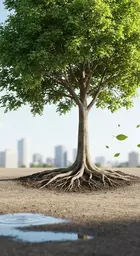Soil Composition
Different soil types retain moisture differently, impacting watering needs.
- Sandy soil drains quickly.
- Clay soil retains moisture longer.
Subscribe to get expert tips and the latest insights on tree care and urban greening directly to your inbox.
Posted on: 2025-04-18
By: Keira Vallejo
Did you know that a well-watered tree can significantly improve air quality and enhance urban landscapes? Understanding how to care for these vital components of our cities can lead to healthier environments for everyone. Dive deeper into the importance of tree watering and discover practical strategies to support urban forestry.
Understanding the factors that influence tree watering can greatly enhance urban tree health and sustainability.
Different soil types retain moisture differently, impacting watering needs.
Some trees are more drought-resistant than others, affecting their watering requirements.
Watering needs shift throughout the year, requiring adjustments based on weather. This is especially important when selecting the right watering schedule for summer months.
Have you ever wondered how trees manage to thrive in the bustling environment of a city? The answer lies in proper watering. Just like us, urban trees depend on water not just for survival, but to flourish amidst concrete and steel. As someone dedicated to urban forestry, I can’t stress enough how crucial it is to understand the significance of tree watering in our city landscapes!
When we take the time to ensure our trees are adequately hydrated, we support their overall health and longevity. Trees that receive the right amount of water can develop strong roots, resist pests and diseases, and contribute to a healthier urban ecosystem. It's a win-win situation for both the trees and the communities they serve!
Watering urban trees is not just about keeping them alive; it’s about enhancing their role in the community. Proper watering practices can lead to stronger growth, more vibrant foliage, and increased resistance to environmental stressors. Have you ever noticed how a well-watered tree can stand tall and proud, adding beauty to its surroundings?
When watering trees, we must consider their specific needs. For instance, the age of the tree, the type of soil, and the local climate all influence how much water a tree requires. Here are some essential factors to keep in mind:
Well-watered trees play a vital role in improving urban environments. They do more than just beautify our streets; they also provide significant environmental benefits. Healthy trees can improve air quality, reduce heat, and even manage stormwater runoff! Can you imagine how much better our cities would feel with more thriving green spaces? In fact, studies show a strong correlation between urban green spaces and improved mental well-being.
Let’s look at some specific benefits of maintaining well-watered trees:
Integrating tree care into city planning is essential for sustaining urban greenery. It's not just about planting trees; it’s about creating a framework that ensures their survival and growth. As an advocate for urban forestry, I believe that city planners should prioritize tree care in their designs. Careful consideration should be given to selecting appropriate tree species for the urban environment.
To achieve this, cities can adopt comprehensive tree care strategies that focus on:
By weaving these elements into urban planning, we can create vibrant, green spaces that enhance the quality of life for all residents. Remember, every action counts in making our cities greener!
To enhance the effectiveness of your tree watering efforts, consider implementing a mulching strategy. Applying a layer of organic mulch around the base of your trees can help retain soil moisture, regulate temperature, and suppress weeds. This simple practice not only benefits tree health but also reduces the frequency of watering needed!
As we wrap up our discussion on tree watering, it’s crucial to highlight the best practices we've covered. Proper watering is not just about quenching a tree's thirst; it supports their overall health and contributes to the vibrancy of our urban landscapes. With the right techniques in place, we can ensure that our city trees thrive, providing the many benefits they offer, from cleaner air to improved aesthetics.
Here are some key takeaways that I’ve found particularly useful in my years of experience with urban forestry:
By following these practices, we can create healthier environments for ourselves and future generations. Remember, a well-cared-for tree not only enhances our urban spaces but also contributes to our well-being!
One of the best aspects of urban tree care is the opportunity to connect with others who share your passion. Engaging with local gardening communities can provide you with invaluable insights and support. As I’ve learned through my journey with the Urban Canopy Blog, collaboration is key! For more information on the benefits of professional care, check out our article on professional tree care.
Here are a few ways to connect with local experts and organizations:
Don’t underestimate the power of community engagement. Whether it’s through volunteering for tree planting events or simply sharing your tree care tips with neighbors, every little bit helps in creating a greener city. Plus, you might just make some lifelong friends along the way!
For those looking to dive deeper into tree care, there are plenty of resources available. Books, online forums, and local extension services can provide excellent information tailored to urban environments. Here are some additional resources that I recommend:
With these resources at your fingertips, you can expand your knowledge and become a champion for urban trees in your community. Remember, every effort counts towards creating a thriving urban ecosystem! Let's make our cities greener together! For a comprehensive guide to seasonal tree care, consider our seasonal urban tree care guide.
Here is a quick recap of the important points discussed in the article:
Proper watering is essential for the health and longevity of urban trees. It supports strong growth, helps them resist pests and diseases, and enables them to fulfill their vital role in the urban ecosystem.
Several factors influence a tree's watering needs, including soil composition (sandy soil drains quickly, clay soil retains moisture longer), tree species (some are more drought-resistant than others), and seasonal changes (watering needs increase during droughts and decrease in rainy seasons).
Well-watered trees offer numerous environmental benefits: They improve air quality by absorbing carbon dioxide and releasing oxygen, regulate temperature by providing shade, and help manage stormwater runoff by absorbing excess rainwater.
Engage with your local gardening community by attending workshops, joining community groups focused on urban forestry, and following local non-profit organizations dedicated to enhancing urban green spaces. Collaborating and sharing knowledge is key to creating a greener city.
Best practices include understanding the specific watering needs of both newly planted and established trees, employing deep root watering techniques, and adjusting watering frequency according to the local climate and seasonal changes. Always be mindful of the specific needs of each tree and the surrounding conditions.

 As urban environments evolve, the resilience of trees becomes increasingly critical in combating cli
As urban environments evolve, the resilience of trees becomes increasingly critical in combating cli
 What if the key to combating urban food insecurity lies in our own backyards? Urban fruit trees not
What if the key to combating urban food insecurity lies in our own backyards? Urban fruit trees not
 Urban environments are often described as concrete jungles, but they can also be vibrant ecosystems
Urban environments are often described as concrete jungles, but they can also be vibrant ecosystems